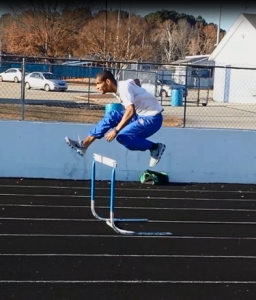Cycle Ladder Drill
For this month’s workout I want to introduce a drill that I created last year as an off-shoot of the quick-step drill I commonly have my hurdlers do. It’s designed more for advanced hurdlers than beginners. The cycle hurdle drill, as I call it, is designed to teach the legs to cycle over the hurdle. To put it another way, it’s designed to teach the legs to continue to run over the hurdle without pausing, kicking, or adding in a motion that is powerful or effort-ful. The idea is to teach the body to flow over the hurdle.
[am4show not_have=’g5;’]
[/am4show][am4guest]
[/am4guest][am4show have=’g5;’]
The Drill:
Set up seven hurdles.
The hurdles are set at a height that is 6 inches lower than race height.
Place the first hurdle anywhere on the straight-away.
Spacing should be as follows:
- 9 feet between hurdles 1 and 2.
- 9 feet between hurdles 2 and 3.
- 12 feet between hurdles 3 and 4
- 12 feet between hurdles 4 and 5
- 15 feet between hurdles 5 and 6.
- 15 feet between hurdles 6 and 7.
The hurdler approaches the first hurdle with low hands and low knees, but cycling. The hurdlers pushes off the back leg while diving into hurdle one, and then pushing back down to the track. After a super-quick three-step in between, clear hurdle two. As the spacing increases at hurdles 4 and again at h urdle 6, the goal is to maintain the same cadence from the previous spacing. You don’t want to feel like you’re reaching, running, or speeding up. The idea is to continue cycling, and to rely on your forward lean over the hurdle, as well as the high and tight action of the trail leg, to propel you forward.
As the hurdler becomes more proficient with the drill, the spacing will increase. Over the course of a month or so, the idea is to gradually get to a point where the first two are 15 feet apart, the next two 18 feet apart, and the last two 21 feet apart. The idea is to continually trick the body into thinking that it doesn’t need to speed up, but just maintain the quickness. As the spacing increases, the speed to the first hurdle will speed up so that the feeling (and cadence) between the hurdles stays the same.
The hurdles shouldn’t be raised until the cycle motion has been mastered at the current height.
The video below of my man Hector Cotto demonstrates a different version of the drill, in which all the hurdles are the same distance apart – 15 feet. It might be best to start with this version so the consistency of the spacing can help to ingrain a consistency of the cadence.
The photo below gives a good picture of what the hurdler should look like on top of the hurdle.
[/am4sh0w]

